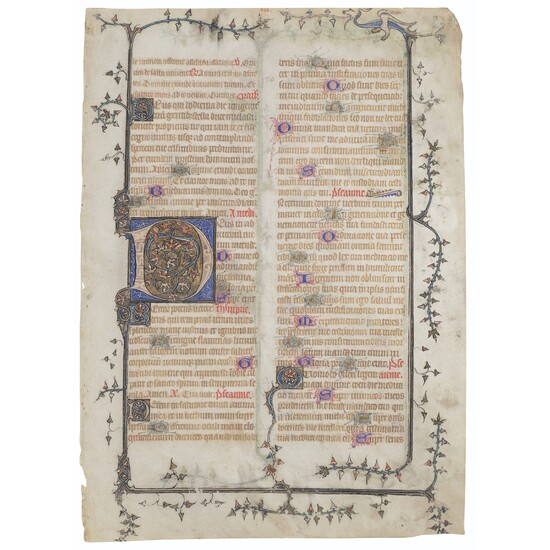Anonymous Parisian artist
Anonymous Parisian artist
A leaf from a Breviary, in Latin and French, illuminated manuscript on vellum [northern France, likely Paris, late 14th century]
A leaf from a glamorous 14th-century French Breviary made for a Franciscan house. The parent manuscript was broken up and dispersed in the first decades of the 20th century: sister leaves are held in private collections across the world.
235 x 170mm. Recto and verso with two columns of 36 lines, written space: 170 x 120mm, rubrics in red, part of a contemporary folio number in red at the top of the recto ('xix'), one-line initials alternate blue and gold with penwork, two-line initials in blue or pink on a gold ground with ivy-leaf infill, large illuminated initial 'D' (opening Terce; 'Deus in adiutorium') on a burnished gold ground enclosing two entwined animals with ivy-leaf extensions to their tails, ivy-leaf bar borders on recto and verso (lightly rubbed at lower margin of recto, small vertical split between the columns). Framed.
Provenance: (1) The lavishly-decorated Breviary from which this leaf comes would have been produced in northern France, probably Paris, towards the end of the 14th century, based on the style of the decoration. It was likely made for a Franciscan house: sister leaves refer to St Aegidius/Gilles [of Assisi; companion of St Francis] as 'our patron'. (2) The parent manuscript was likely broken up in the late 1920s or early 1930s; the leaves first begin to appear on the market in 1931, in the Quaritch catalogue for that year (nos 127-8 are both described as comprising 'a few leaves' each). Further sister leaves appear: with the Society for Italic Handwriting (2 leaves; a bequest of Lord Cholmondeley); private UK collection (bought from Quaritch in 1950); Sotheby's, 5 April 1976, part of lot 601 (the teaching collection of A.N.L. Munby); Sotheby's, 19 June 1979, lot 3 (thence to a Swiss private collection); Christie's New York, 25 September 1981, lot 16; Sotheby's, 8 December 1981, lot 3; Quaritch, cat. 1056, 1985, no 69; Sotheby's, 24 June 1986, lot 50; Sotheby's, 22 June 1988, lot 11; Maggs, Bulletin 10, 1979 (now Tokyo, Keio University Library); and Bloomsbury, 6 July 2021, lot 56 (from the Roger Martin collection). (3) The present leaf appears to have been with Phyllis Lucas Gallery, New York, according to a label on the frame. (4) Dr Freidrich G. Zeileis; see his catalogue Piu ridon le carte: Buchmalerei aus Mittelalter und Renaissance, 2004, item 142. (5) Sotheby's, 5 December 2006, lot 55.
View it on
Sale price
Estimate
Time
Auction House
Anonymous Parisian artist
A leaf from a Breviary, in Latin and French, illuminated manuscript on vellum [northern France, likely Paris, late 14th century]
A leaf from a glamorous 14th-century French Breviary made for a Franciscan house. The parent manuscript was broken up and dispersed in the first decades of the 20th century: sister leaves are held in private collections across the world.
235 x 170mm. Recto and verso with two columns of 36 lines, written space: 170 x 120mm, rubrics in red, part of a contemporary folio number in red at the top of the recto ('xix'), one-line initials alternate blue and gold with penwork, two-line initials in blue or pink on a gold ground with ivy-leaf infill, large illuminated initial 'D' (opening Terce; 'Deus in adiutorium') on a burnished gold ground enclosing two entwined animals with ivy-leaf extensions to their tails, ivy-leaf bar borders on recto and verso (lightly rubbed at lower margin of recto, small vertical split between the columns). Framed.
Provenance: (1) The lavishly-decorated Breviary from which this leaf comes would have been produced in northern France, probably Paris, towards the end of the 14th century, based on the style of the decoration. It was likely made for a Franciscan house: sister leaves refer to St Aegidius/Gilles [of Assisi; companion of St Francis] as 'our patron'. (2) The parent manuscript was likely broken up in the late 1920s or early 1930s; the leaves first begin to appear on the market in 1931, in the Quaritch catalogue for that year (nos 127-8 are both described as comprising 'a few leaves' each). Further sister leaves appear: with the Society for Italic Handwriting (2 leaves; a bequest of Lord Cholmondeley); private UK collection (bought from Quaritch in 1950); Sotheby's, 5 April 1976, part of lot 601 (the teaching collection of A.N.L. Munby); Sotheby's, 19 June 1979, lot 3 (thence to a Swiss private collection); Christie's New York, 25 September 1981, lot 16; Sotheby's, 8 December 1981, lot 3; Quaritch, cat. 1056, 1985, no 69; Sotheby's, 24 June 1986, lot 50; Sotheby's, 22 June 1988, lot 11; Maggs, Bulletin 10, 1979 (now Tokyo, Keio University Library); and Bloomsbury, 6 July 2021, lot 56 (from the Roger Martin collection). (3) The present leaf appears to have been with Phyllis Lucas Gallery, New York, according to a label on the frame. (4) Dr Freidrich G. Zeileis; see his catalogue Piu ridon le carte: Buchmalerei aus Mittelalter und Renaissance, 2004, item 142. (5) Sotheby's, 5 December 2006, lot 55.



